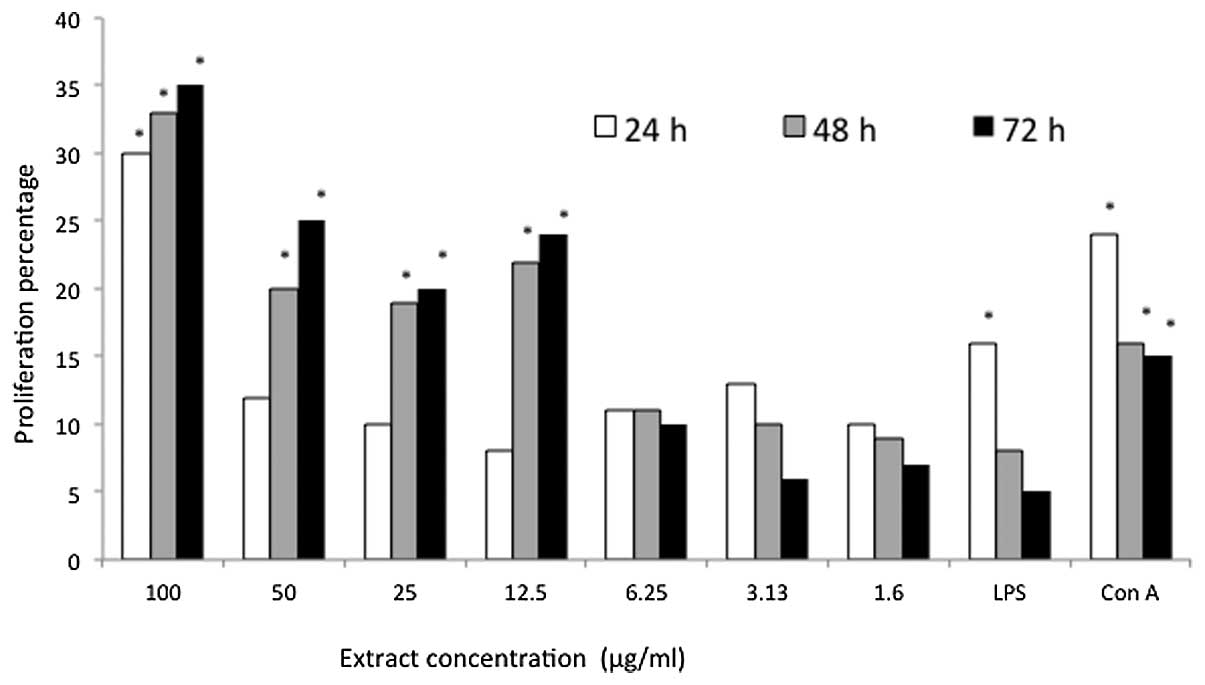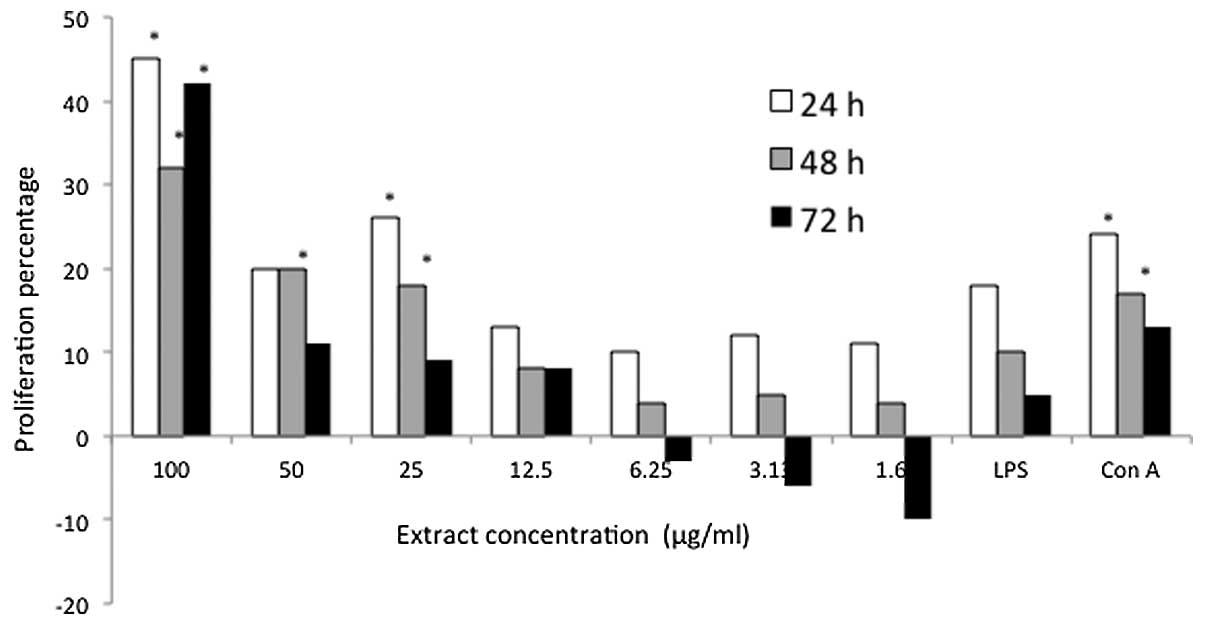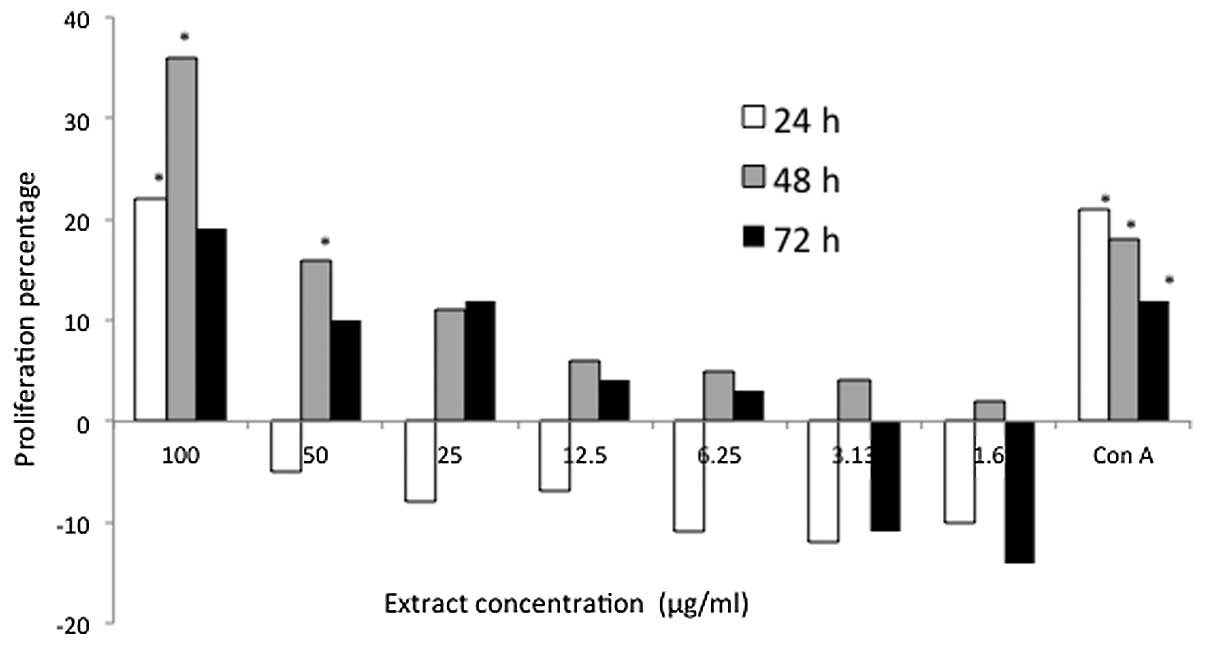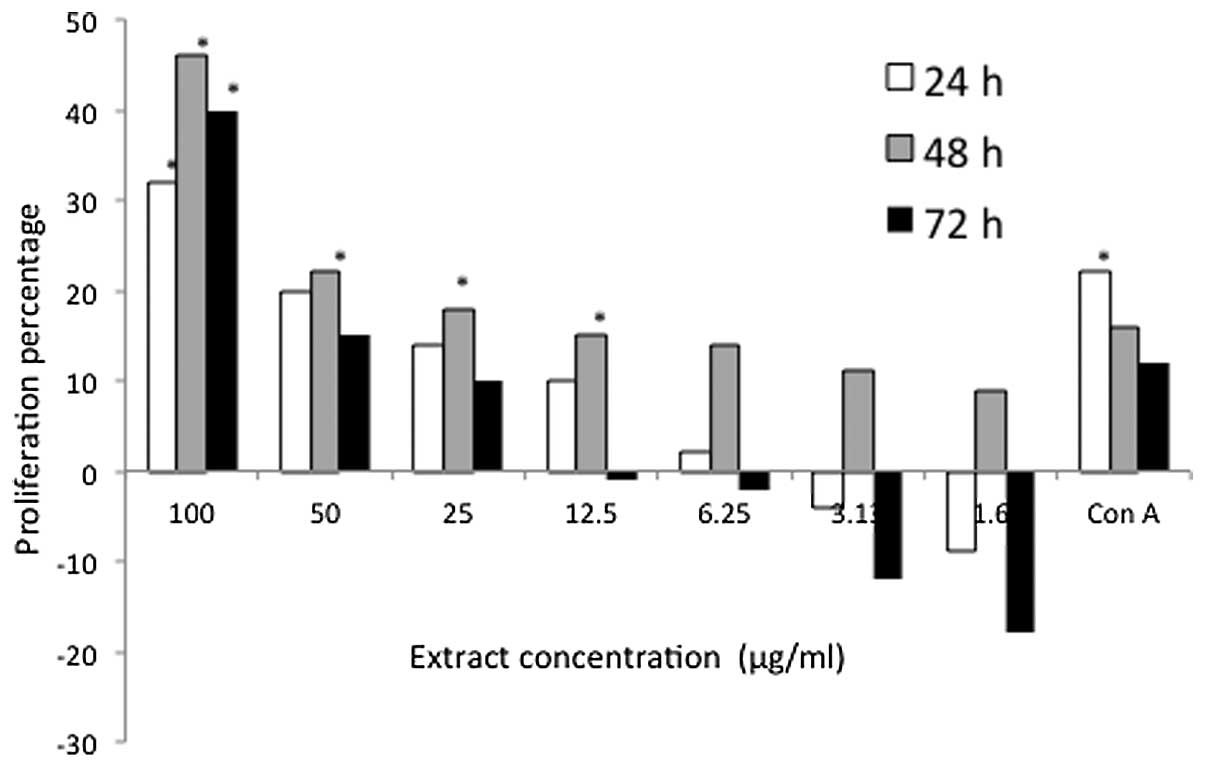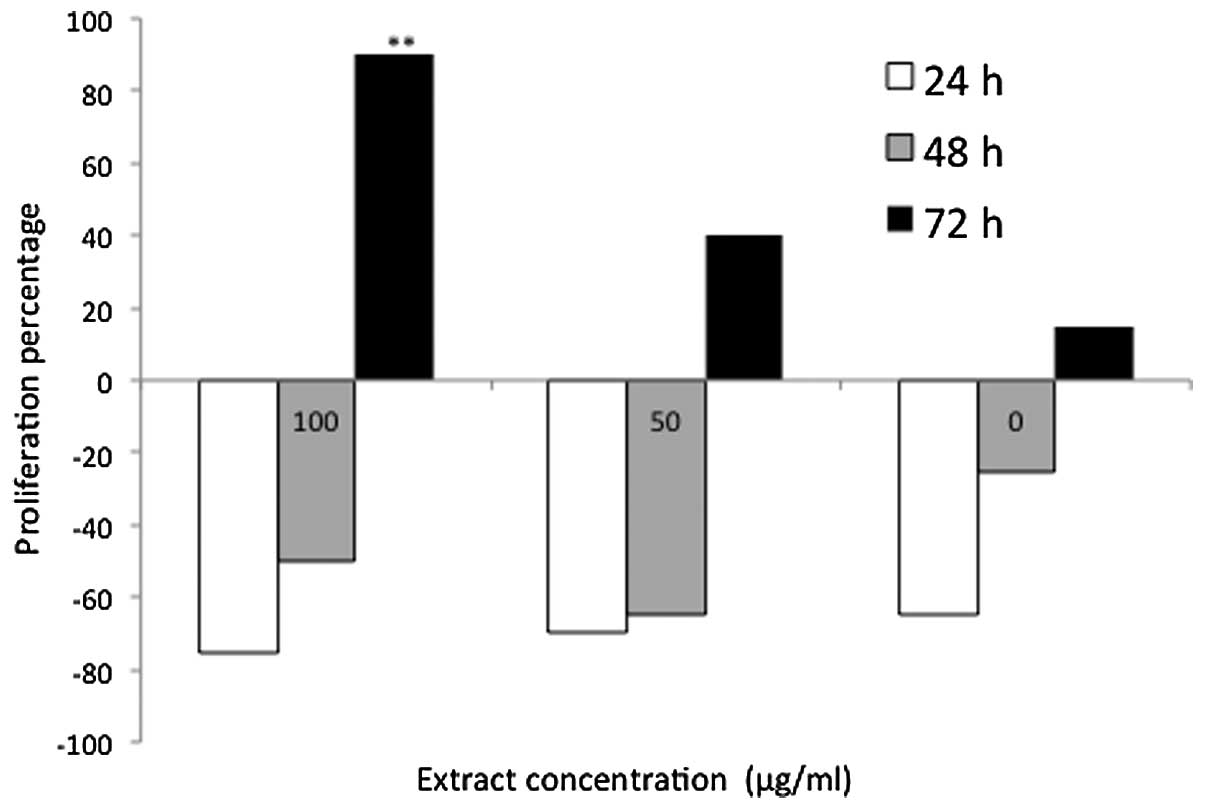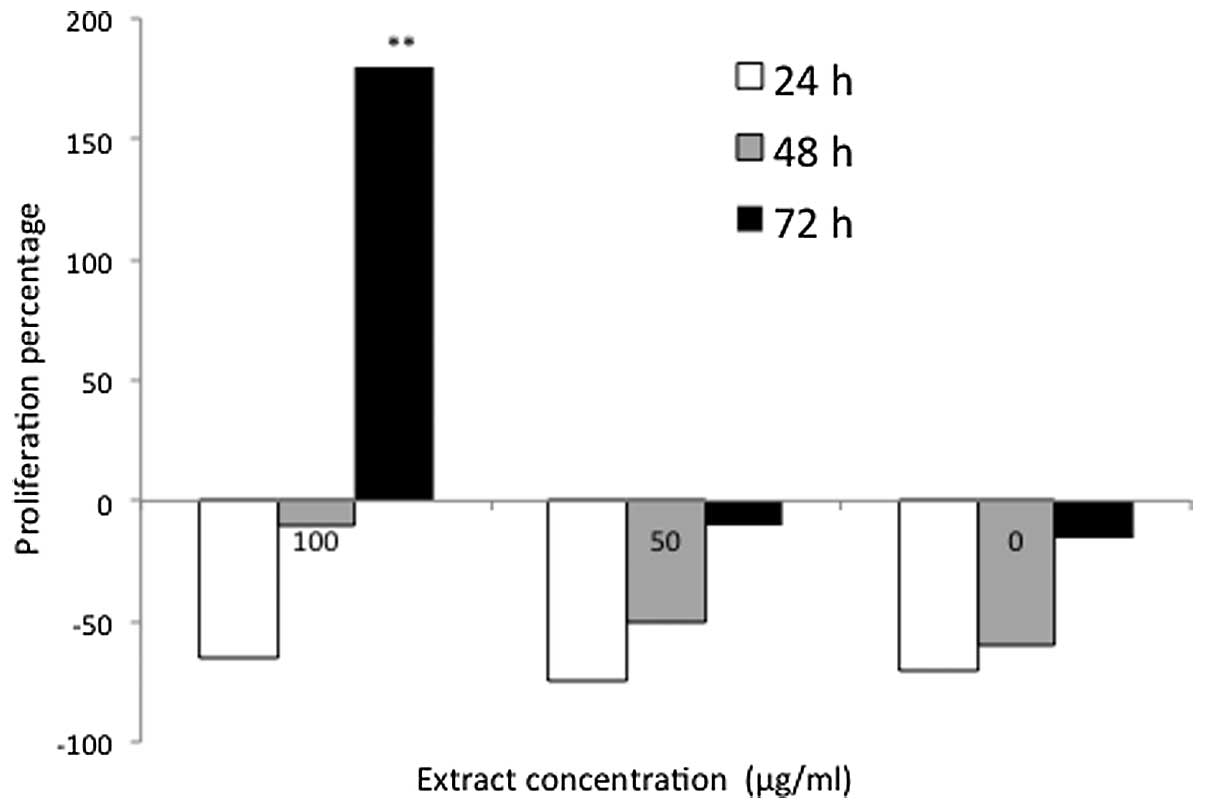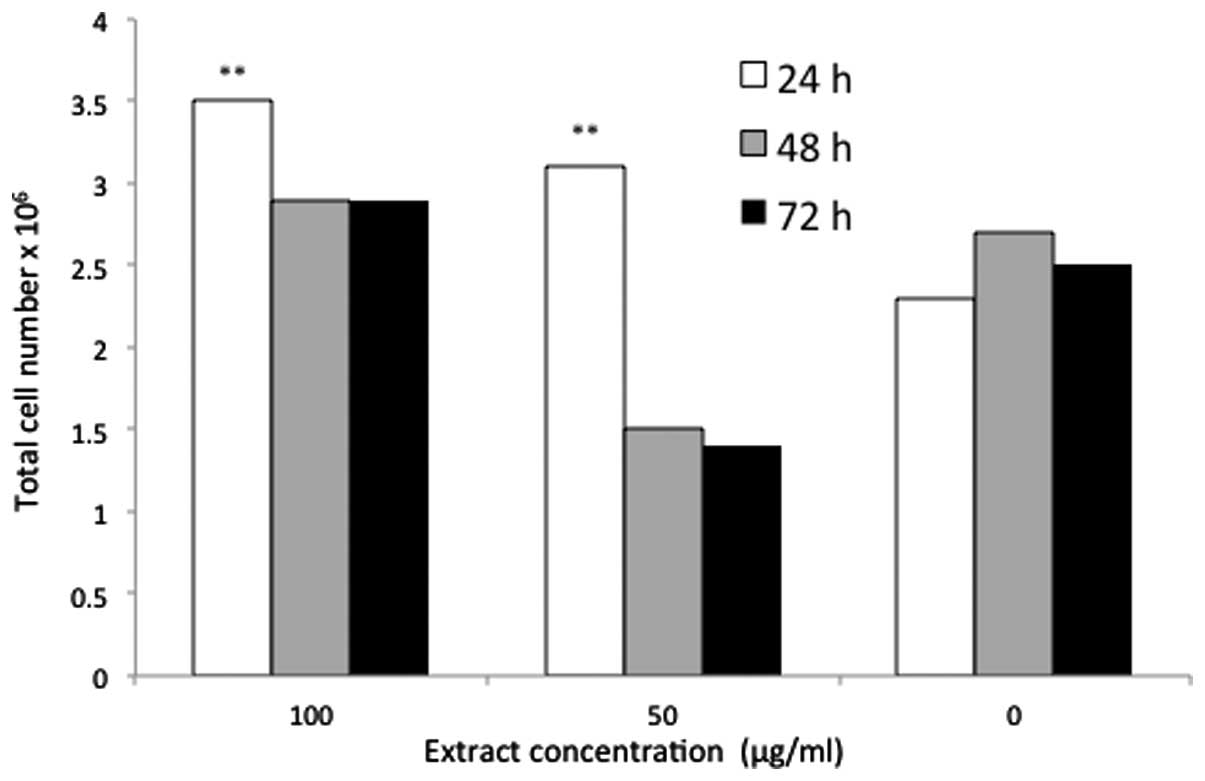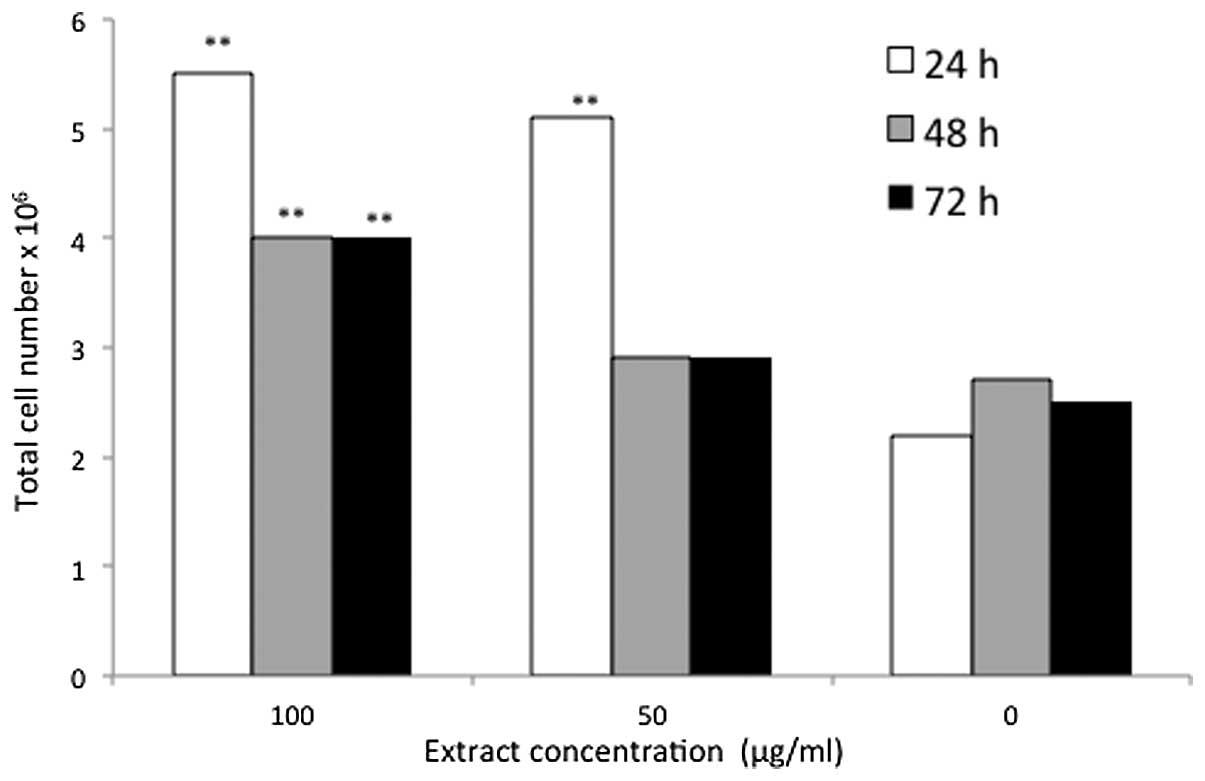Immunomodulatory effects of Potentilla indica and Dendrophthoe pentandra on mice splenocytes and thymocytes
- Authors:
- Published online on: April 2, 2014 https://doi.org/10.3892/etm.2014.1657
- Pages: 1733-1737
Abstract
Introduction
A promising and recently identified alternative to classical antibiotic treatment is the use of immunomodulators, which enhance immune reactions via the stimulation of non-specific systems, such as granulocytes, macrophages, complement, certain T-lymphocytes and various effector substances (1,2). Several studies have focused on identifying compounds that are able to modulate the biological response of immune cells thereby enhancing the immunity of the host against various diseases (3,4). The increasing interest in folk medicine is due numerous well known plant remedies that are able to exert their anti-infective influence by directly affecting the pathogen, in addition to affecting immune cells by improving their activity. These effects were partially contributed to by the stimulation of the natural and adaptive defense mechanisms of the host organism (5). Recent advances have successfully identified a large number of macromolecules that regulate the host-defense system and the majority of which result in enhancement, amplification and/or diversion of immune responses in positive and therapeutically desirable directions (6).
Potentilla indica (formally known as Duchesnea indica) is a member of the Rosaceae family, which is native to eastern and southern Asia and is commonly termed a mock strawberry. It exhibits a moderate cytotoxic effect against various cancerous cell lines (7–10) and limited inhibitory activity against normal cell growth (11). However, few studies were conducted to investigate the additional bioactivities of this plant, such as its immunomodulatory effect. Conversely, Dendrophthoe pentandra is a type of mistletoe that grows on the rambutan tree. Although mistletoe is a parasitic plant, it has been widely administered in traditional medicine for the treatment of coughs and cancer, and as a diuretic agent. Furthermore, various antioxidant compounds, such as flavonol glycoside and quercitrin, have been isolated from the ethanol extract of D. pentandra and the compounds were shown to contribute to its high antioxidant activity (12). Moreover, it has been demonstrated to enhance the phagocytic activity of macrophages (9). To the best of our knowledge, there is currently no in vitro study on the immunoproliferative effect of the ethanol extract of P. indica and D. pentandra against splenocytes and thymocytes. Therefore, the aim of the present study was to determine the immunomodulatory effects of these plant extracts on mice splenocyte and thymocyte proliferation and viability.
Materials and methods
Plant materials
P. indica and D. pentandra were collected from George Town, Penang, Malaysia and were identified by the Forest Research Institute (Kuala Lumpur, Malaysia). The plant leaves were air-dried at room temperature and 2 g was ground, and soaked in 100 ml ethanol for three days. The extracts were filtered using Whatman filter paper grade 1 (Sigma-Aldrich, St. Louis, MO, USA) and dried via evaporation in a reduced-pressure atmosphere using an Aspirator A-3S (EYELA, Tohoku, Japan) at <45°C. This process was repeated three times and the yield was 8.7%, w/w. The dried residue was suspended in dimethylsulfoxide (DMSO; Fisher Scientific, Loughborough, UK) as extract stock. Briefly, 0.1 g dried extract was dissolved in 1 ml DMSO to prepare a 10 mg/ml stock extract. The sub-stock solution (0.2 mg/ml) was prepared by diluting 20 μl stock solution in 980 μl serum-free Dulbecco’s modified Eagle’s medium (DMEM; Sigma-Aldrich). The percentage of DMSO used was <0.5% and the stock and sub-stock solutions were stored at 4°C.
Animals
Imprinting control region mice (age, 5–8 weeks) were used in the present study. The mice were purchased from the Animal House, Universiti Putra Malaysia (Selangor, Malaysia). The mice were housed under standard conditions at 25±2°C and fed with standard pellets and tap water. The mice were protected from stress. The present study was approved by the Institutional Animal Care and Use Committee of the Universiti Putra Malaysia (Ref: UPM/FPV/PS/3.2.1.551/AUP-R2).
Preparation of mouse thymus and spleen cell suspensions
Following the sacrifice of the mice by cervical dislocation, the thymus and spleen were removed and washed three times using Hanks’ balanced salt solution (Sigma-Aldrich). The thymus and spleen were pulverized separately using a rubber syringe plunger and pushed through an 80 μm sterile wire mesh screen in phosphate-buffered saline (PBS), which was supplemented with 0.1% (w/v) bovine serum albumin (BSA) and 2 mg/ml EDTA (PBS/BSA/EDTA; Sigma-Aldrich) solution, to obtain a single cell suspension. For the spleen cell suspension, the red blood cells were removed using a lysis buffer and the spleen and thymus cell suspensions were washed twice using the PBS/BSA/EDTA solution and suspended in DMEM, which was supplemented with 10% heat inactivated fetal bovine serum (PAA, Pasching, Austria). Cell counting was performed using a hemocytometer to determine the number of lymphocytes within the cell suspension.
MTT cell proliferation assay
The lymphocytes were harvested during the logarithmic growth phase and seeded in 96-well plates at a density of 5×105 cells/ml with a final volume of 100 μl/well. Following incubation for 24 h, 100 μl P. indica or D. pentandra extract (200 μg/ml) was loaded into the well plates and serially diluted. After 24, 48 and 72 h treatment, 20μl MTT (5 mg/ml) was added to each well for 4 h. Subsequently, the supernatant was removed and the MTT crystals were solubilized with 100 μl anhydrous DMSO per well. Thereafter, the cell viability was measured using a μQuant™ ELISA reader (BioTek Instruments Inc., Winooski, VT, USA) at 570 nm absorbance and the percentage of cell proliferation was calculated.
Bromodeoxyuridine (BrdU) incorporation assay
A 96-well plate was used to allocate the different concentrations of extracts (100, 50 and 1 μg/ml) from either P. indica or D. pentandra for incubation with the splenocytes at 5×105 cells/ml media. A BrdU ELISA kit (Chemicon, Temecula, CA, USA) was used with splenocytes, according to the manufacturer’s instructions, to estimate the extent of cell proliferation. The three incubation periods (24, 48 and 72 h) per extract were analyzed three times and three independent repeats of the assay were performed on the cells from the control group. The plate was read at an absorbance of 450 nm using the μQuant ELISA reader.
Trypan blue exclusion method
The splenocytes and thymocytes (5×105 cell/ml) were treated with 100 or 50 μg/ml P. indica or D. pentandra extract in 6-well plates for either 24, 48 or 72 h. The untreated cells served as the negative control. Following the incubation period, the cells were harvested and pelleted at 200 × g for 10 min. The pellets were suspended in 0.4% Trypan blue dye (Sigma-Aldrich) and 10 μl mixture was placed in a hemocytometer (Sigma-Aldrich) and the cells were counted under a phase contrast light microscope (Eclipse Ti, Nikon, Melville, NY, USA). Each of the extracts and the control were assayed five times in triplicate.
Statistical analysis
The results were expressed as the mean ± standard error of the mean and statistical analyses were performed using SPSS version 16.0 (SPPS Inc., Chicago, IL, USA). The differences between the means were evaluated using one way analysis of variance, followed by Duncan’s test and P≤0.05 was considered to indicate a statistically significant difference.
Results and Discussion
Effects on splenocyte and thymocyte proliferation observed by MTT assay
The predominant function of the thymus is to develop immature T cells into immunocompetent T cells, thus, the thymus contains 99% of mature T lymphocytes (13). By contrast, the spleen contains a relatively homogenous fraction of B and T lymphocytes, consisting of ~60% B cells and 40% T cells (14). Thus, an evaluation of the immunoproliferative effect on these cells provides an understanding of the influence of the leaf extract on T and B cells. The MTT-based lymphocyte proliferation assay was performed on specific immune cells at different incubation periods and the proliferation effects of P. indica and D. pentandra were analyzed using various stock concentrations, between 1.563 and 100 μg/ml. Two mitogens were used in the present study; lipopolysaccharide (LPS) as the B cell mitogen and concanavalin A (Con A) as the T cell mitogen. All of the P. indica extract concentrations stimulated the proliferation of the mice splenocytes at all of the incubation times; however, an inhibition of 0.1256% was observed at the 6.25 μg/ml concentration following 48 h of incubation (Fig. 1). By contrast, the proliferation of the mice splenocytes induced by 100 μg/ml P. indica extract increased from 30% at 24 h to 33% after 48 h of treatment. The greatest proliferation (35%) was obtained following 72 h of treatment with the same concentration of extract. Furthermore, the two positive controls were observed to stimulate proliferation of the mice splenocytes in a time-dependent manner. However, treatment with P. indica extract indicated an improved stimulatory effect, exhibiting 30 and 19% more proliferation than the LPS and Con A groups, respectively, following 72 h of treatment. Furthermore, the predominant immunostimulatory effect of D. pentandra extract on the mice splenocytes was observed at a concentration of 100 μg/ml (Fig. 2). The highest proliferation was observed in the mice splenocytes that were treated with 100 μg/ml D. pentandra extract, although the immunostimulatory effect of D. pentandra extract on the mice splenocytes was markedly weaker at low concentrations. Overall, the pattern of mouse splenocyte proliferation, induced by P. indica and D. pentandra extracts, were somewhat comparable as the two extracts exhibited the majority of active proliferation at a concentration of100 μg/ml.
In addition, P. indica exhibited a marked proliferation effect on T cells, exhibiting induction of 21, 35 and 17% after treatment for 24, 48 and 72 h, respectively, at a concentration of 100 μg/ml (Fig. 3). The highest stimulatory effect by P. indica extract on the mouse thymocytes (proliferation, 35%) was observed following 48 h at a concentration of 100 μg/ml. Moreover, it was evident that the proliferation of mouse thymocytes reduced significantly throughout the treatment periods when they were treated with low concentrations (≤50 μg/ml) of P. indica extract. When compared with the stimulatory effect of 100 μg/ml P. indica extract, thymocyte proliferation, which was induced by the extract remained higher than the proliferation that was induced by Con A. A notable proliferation effect was observed at the highest concentration (100 μg/ml) of D. pentandra extract, with values of 33, 44 and 41% observed throughout the 24, 48 and 72 h treatment periods, respectively (Fig. 4). Similarly, the stimulatory effect of 100 μg/ml D. pentandra extract on mouse thymocyte proliferation was greater than that of the positive control.
BrdU incorporation assay on splenocytes
DNA synthesis in cells treated with P. indica extract for 24 and 48 h was markedly reduced at all of the concentrations that were employed in the present study (100, 50 and 1 μg/ml), indicating a non-stimulatory effect, which ranged from −28 to −78% (Fig. 5). An incremental increase in DNA synthesis in the P. indica-treated cells was observed following a prolonged incubation period of 72 h with 1, 50 and 100 μg/ml P. indica extract; the DNA synthesis rate was 87, 18 and 42%, respectively. The D. pentandra-treated cells exhibited the greatest rate of DNA synthesis, which reached 187% following 72 h of treatment with 100 μg/ml D. pentandra extract (Fig. 6). This demonstrated a 100% elevation in the proliferation rate of the D. pentandra-treated cells when compared with the P. indica-treated cells under matching concentration and incubation conditions. However, this was the only positive result that was observed in the D. pentandra-treated cells, whereas the non-stimulatory effect, ranging from −9 to −81%, was observed at all of the other concentrations and incubation periods. These results indicated that P. indica- and D. pentandra-treated cells exhibited the highest rate of DNA synthesis following 72 h of treatment, when the greatest concentration (100 μg/ml) was used. The cells were sustained for longer in the medium of the two extracts without exhibiting signs of inhibition or toxicity, however, MTT assays have previously been reported to overestimate proliferation (15) or underestimate the growth inhibitory effects of specific cytokines (16). These assays exhibited less sensitivity when compared with fluorescent labeling techniques (17) and occasionally failed to detect the proliferation of lymphocytes (18–20). In the present study, as the MTT and BrdU assays indicated positive correlations, it could be deduced that these techniques were effective in detecting the proliferation of mice splenocytes and thymocytes.
Trypan blue exclusion assay
The total cell population was increased to 3.5×106, 2.85×106 and 2.8×106 cells following treatment for 24, 48 and 72 h, respectively, with 100 μg/ml P. indica extract. The total cell number (3.5×106) was the highest proliferation rate achieved as a result of treatment with P. indica extract, which was followed by 3.1×106 cells that was observed following 24 h of treatment with 50 μg/ml P. indica extract (Fig. 7). The greatest cell number (5.54×106 cells) was achieved following 24 h of treatment with 100 μg/ml D. pentandra, this was followed by 5.12×106 cells at the concentration of 50 μg/ml. Following 48 and 72 h, the total cell population resulting from treatment with 100 μg/ml D. pentandra extract did not differ; 4.16×106 cells were obtained over the two time periods. Moreover, a comparable pattern was observed in the D. pentandra treatment group at a concentration of 50 μg/ml, where 2.88×106 cells were obtained following incubation for 48 and 72 h (Fig. 8). The two extracts demonstrated that increases in cell number were time- and dose-dependent and the highest cell population count was observed following 24 h of incubation with the greatest concentration (100 μg/ml) of P. indica or D. pentandra extract. When comparing the two extracts, D. pentandra exhibited a greater stimulatory effect regarding the number of viable cells, the rate of DNA synthesis and the total cell population. However, the effect of these extracts requires further investigation to isolate and evaluate the active metabolites from the extracts, which contribute to the immunomodulatory effect on thymocytes and splenocytes.
In conclusion, P. indica and D. pentandra extracts stimulated the proliferation of mice splenocytes and thymocytes in a time- and dose-dependent manner. The D. pentandra extracts demonstrated a greater stimulatory effect on mice splenocytes and thymocytes when compared with the P. indica extracts. The ability of these plant extracts to modulate innate immune functions suggests promising further therapeutic development on wound healing and inhibition of tumor growth through modulation of lymphocytes.
References
|
Beutler B: Innate immunity: an overview. Mol Immunol. 40:845–859. 2004. View Article : Google Scholar | |
|
Tzianabos AO: Polysaccharide immunomodulators as therapeutic agents: structural aspects and biologic function. Clin Microbiol Rev. 13:523–533. 2000. View Article : Google Scholar : PubMed/NCBI | |
|
Farnsworth NR, Akerele O, Bingel AS, et al: Medicinal plants in therapy. Bull World Health Organ. 63:965–981. 1985.PubMed/NCBI | |
|
Baker JT, Borris RP, Carté B, et al: Natural product drug discovery and development: new perspectives on international collaboration. J Nat Prod. 58:1325–1357. 1995. View Article : Google Scholar : PubMed/NCBI | |
|
Guerra RN, Pereira HA, Silveira LM and Olea RS: Immunomodulatory properties of Alternanthera tenella Colla aqueous extracts in mice. Braz J Med Biol Res. 36:1215–1219. 2003. | |
|
Wagner H: Search for plant derived natural products with immunostimulatory activity (recent advances). Pure Appl Chem. 62:1217–1222. 1990. View Article : Google Scholar | |
|
Peng B, HU Q, Liu X, et al: Duchesnea phenolic fraction inhibits in vitro and in vivo growth of cervical cancer through induction of apoptosis and cell cycle arrest. Exp Biol Med (Maywood). 234:74–83. 2009. View Article : Google Scholar : PubMed/NCBI | |
|
Peng B, Chang Q, Wang L, et al: Suppression of human ovarian SKOV-3 cancer cell growth by Duchesnea phenolic fraction is associated with cell cycle arrest and apoptosis. Gynecol Oncol. 108:173–181. 2008. View Article : Google Scholar : PubMed/NCBI | |
|
Zhao L, Zhang SL, Tao JY, et al: Anti-inflammatory mechanism of a folk herbal medicine, Duchesnea indica (Andr) Focke at RAW264.7 cell line. Immunol Invest. 37:339–357. 2008. View Article : Google Scholar : PubMed/NCBI | |
|
Kayser O, Masihi KN and Kiderlen AF: Natural products and synthetic compounds as immunomodulators. Exp Rev Anti Infect Ther. 1:319–335. 2003. View Article : Google Scholar : PubMed/NCBI | |
|
Shoemaker M, Hamilton B, Dairkee SH, Cohen I and Campbell MJ: In vitro anticancer activity of twelve Chinese medicinal herbs. Phytother Res. 19:649–651. 2005. View Article : Google Scholar : PubMed/NCBI | |
|
Rhodes J: Discovery of immunopotentiatory drugs: current and future strategies. Clin Exp Immunol. 130:363–369. 2002. View Article : Google Scholar : PubMed/NCBI | |
|
Nowell PC: Phytohemagglutinin: an initiator of mitosis in cultures of normal human leukocytes. Cancer Res. 20:462–466. 1960.PubMed/NCBI | |
|
Andersson J, Sjöberg O and Möller G: Mitogens as probes for immunocyte activation and cellular cooperation. Transplant Rev. 11:131–177. 1972.PubMed/NCBI | |
|
Wong KT and Tan BK: In vitro cytotoxicity and immunomodulating property of Rhaphidophora korthalsii. J Ethnopharmacol. 52:53–57. 1996. View Article : Google Scholar : PubMed/NCBI | |
|
Denizot F and Lang R: Rapid colorimetric assay for cell growth and survival. Modifications to the tetrazolium dye procedure giving improved sensitivity and reliability. J Immunol Methods. 89:271–277. 1986. View Article : Google Scholar | |
|
Durrieu C, Degraeve P, Carnet-Pantiez A and Martial A: Assessment of the immunomodulatory activity of cheese extracts by a complete and easy to handle in vitro screening methodology. Biotechnol Lett. 27:969–975. 2005. View Article : Google Scholar : PubMed/NCBI | |
|
Jabbar SA, Twentyman PR and Watson JV: The MTT assay underestimates the growth inhibitory effects of interferons. Br J Cancer. 60:523–528. 1989. View Article : Google Scholar : PubMed/NCBI | |
|
Bergler W, Petroianu G and Schadel A: Feasibility of proliferation studies using the BrdU and MTT assays with a head and neck carcinoma cell line. ORL J Otorhinolaryngol Relat Spec. 55:230–235. 1993. View Article : Google Scholar : PubMed/NCBI | |
|
Chen CH, Campbell PA and Newman LS: MTT colorimetric assay detects mitogen responses of spleen but not blood lymphocytes. Int Arch Allergy Appl Immunol. 93:249–255. 1990. View Article : Google Scholar : PubMed/NCBI |



